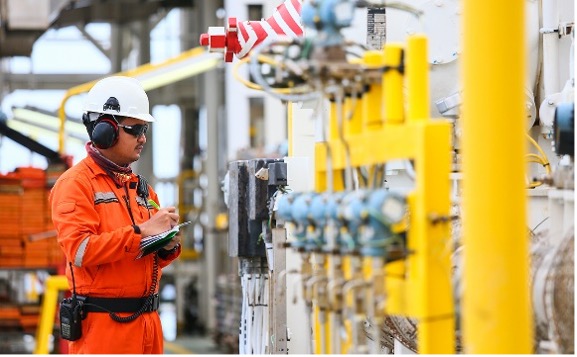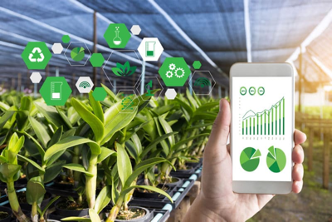What is Environmental Monitoring?
IoT-based environmental monitoring entails the systematic gathering of measurements and data from the physical environment by utilizing sensors and interconnected devices. These sensors can be integrated into various infrastructures such as irrigation systems, pipelines, tanks, weather stations, oceanic applications, and industrial equipment, encompassing locations across the globe. The data obtained from these sensors encompasses crucial parameters such as temperature, moisture, water levels, leaks, and other physical properties. Intelligent and interconnected devices equipped with embedded communication modules subsequently process this acquired information employing edge computing technology. The processed data is then expediently transmitted to either the cloud or a data center for further analysis or appropriate action2. Such monitoring systems can be programmed to identify irregularities or specific conditions, subsequently triggering alerts via email or text messages, and even initiating automated procedures. These automated processes can encompass various actions ranging from generating service tickets to system shutdowns, all aimed at averting potential disasters. In essence, an environmental monitoring system employing IoT technology assumes the role of an observer, listener, and reporter for diverse processes, and may even act proactively to prevent potential damage3.
How can IoT improve Environmental Monitoring?
An IoT-based environmental monitoring system offers a plethora of benefits, encompassing:
- Enhanced Environmental Understanding: By receiving real-time data from remotely deployed IoT sensors, businesses, and organizations gain a deeper comprehension and quantification of the environment. This enables them to take targeted actions aimed at reducing environmental impact and promptly identifying issues such as excessive CO2 levels, noise pollution, or airborne chemicals as they arise.
- Improved Operational Efficiency: Leveraging real-time data empowers organizations to proactively address and resolve problems well before they escalate. By utilizing warning alarms, businesses can respond swiftly and proactively, leading to a more efficient working environment, cost savings, and reduced downtime.
- Heightened Sustainability: IoT environmental monitoring systems facilitate the identification of areas where organizations can mitigate their environmental impact on employees and stakeholders, promoting long-term sustainability practices.
- Fostered Business Growth: Compliance with environmental standards is often necessary for companies to demonstrate their progressive values align with their customers’ policies and objectives. Implementing evidenced-based monitoring systems and showcasing tangible results instills greater confidence that appropriate measures and controls are in place, aligning with both the business context and environmental concerns of the organization and its clientele4.
IoT for Environmental Monitoring: 4 Essential Components
Environmental monitoring utilizing IoT technology facilitates real-time data acquisition, empowering operations and IT managers to proactively oversee equipment and processes from any location. Four fundamental components of IoT-based environmental monitoring contribute to crucial insights and decision-making5:
- Environmental Condition Monitoring: Across various fields, industrial sites, and water management systems, the deployment of environmental condition monitors with installed sensors and Digi XBee wireless communication modules, along with sensor connectivity gateways, becomes essential. These interconnected devices efficiently gather and deliver critical information precisely where it is required.
- Data Measurement: To assess environmental impact comprehensively, these systems must be capable of evaluating key data points, encompassing aspects like water and chemical leaks, as well as critical equipment failures. Such data proves invaluable to industrial operators and municipalities, allowing them to quantify their environmental footprint and undertake measures to minimize waste, promote sustainability, manage valuable resources such as water, and forestall environmental disasters.
- Data Cataloguing: The volume of data amassed from environmental monitoring stations worldwide is significant. Establishing global databases, like the Microsoft Planetary Computer, becomes crucial for cataloging a vast array of environmental data. Similarly, industrial sites and enterprises must utilize cloud and data center storage to effectively organize the gathered data, ensuring accessibility for various business applications.
- Provision of Actionable Insights and Analysis: Ultimately, the primary objective is to derive actionable insights from the accumulated data. By integrating Digi’s IoT solutions with cloud applications like Microsoft Azure and Amazon Web Services, data can be channeled into sophisticated software systems, empowering personnel to gain invaluable insights, receive timely alerts and notifications, and take prompt, informed action.
Use Cases for IoT Environment Monitoring
Through the implementation of IoT systems, we gain the capability to interconnect and oversee wireless devices both within an industrial field and on a global scale, facilitating environmental monitoring and management. This, in turn, fosters improved decision-making processes, promotes environmental sustainability, and contributes to the establishment of a circular economy. Now, let us delve into some specific use cases that exemplify how IoT can effectively contribute to environmental preservation and enhancement.
Water Quality Monitoring
The significance of water as a critical resource for the planet and its inhabitants necessitates the implementation of technology to ensure clean water management and conservation. Leveraging IoT-based systems, water quality monitoring emerges as a powerful tool to combat contamination and effectively manage this invaluable resource. These advanced smart water monitoring systems, integrated with IoT technologies, facilitate precise measurements of contaminants, oxygen levels, additional factors, and pH levels. By analyzing water quality in buildings, water and wastewater plants, irrigation systems, and industrial processes, harmful substances can be detected and addressed before they reach homes and buildings, thereby contributing to the preservation of public health and overall wellness6.

Air Quality Monitoring
Industrial processes release various organic compounds, including carbon monoxide, hydrocarbons, and greenhouse gases, into the atmosphere, while vehicle exhaust and methane from cattle further impact air quality and the environment. IoT-enabled air quality monitoring holds the potential for transformative change. These crucial metrics provide municipalities with insights to inform urban planning decisions, empower industrial operations to mitigate their environmental impact, and assist automotive manufacturers in continuously improving designs to reduce emissions. Deploying IoT to manage traffic flow in cities can substantially reduce vehicle emissions, thus supporting the promotion of cleaner air. Real-world examples of air quality monitoring encompass carbon monoxide monitoring in homes and buildings, methane monitoring in agriculture and waste management, and ambient air quality monitoring for pollutants, lead, and toxic particulates.
Energy Monitoring
Given the finite nature of global energy resources, energy monitoring assumes a pivotal role in fostering conservation efforts. IoT-based technologies serve as indispensable tools for managing and optimizing energy usage. Leading energy providers actively integrate a diverse array of IoT monitoring and mitigation techniques to reduce energy consumption and promote sustainability. Such measures not only benefit the environment but also result in cost savings for consumers reliant on the electric grid. Energy monitoring supports multiple energy management goals, including the reduction of fossil fuel usage in homes and businesses, grid stabilization, and the prevention of spikes in energy usage and associated equipment failures and service disruptions.
Toxic Gas Detection
In industrial settings, toxic gas detection systems play a critical role in analyzing air quality to identify harmful, toxic, and flammable gases present in the atmosphere. By swiftly identifying contaminants, these systems avert environmental damage and protect human health. IoT connectivity empowers these monitoring systems to promptly issue critical alerts and initiate necessary actions, such as shutting off valves, halting systems, and triggering fire alarms and chemical mitigation protocols. Real-world applications of toxic gas monitoring include ensuring the safe management of toxic, flammable, or pyrophoric gases, monitoring H2S or CO in refinery and petrochemical applications, safeguarding enclosed spaces such as warehouses and parking garages, and protecting workers from exposure to harmful and corrosive gases in various occupational settings, including mining operations8.

Figure 2: Water Quality Monitoring using IoT Technologies9.
Challenges in Deploying IoT-based Systems for Environmental Monitoring
The current technology for environmental monitoring presents several drawbacks, such as high costs, limited data snapshots, the need for specialized expertise, and time-consuming laboratory analysis. To address these issues, the National Environmental Engineering Research Institute (NEERI) is actively developing a novel technology that incorporates IoT capabilities. This new approach aims to offer affordability, user-friendliness, and continuous data monitoring. However, before its widespread adoption, the technology must undergo QA/QC approval, which currently lacks a centralized agency responsible for such approvals10.
Recent research in sensor technology has primarily focused on microprocessors. NEERI’s system, in contrast, incorporates a diverse range of low-cost components, with individual prices ranging from US$ 100 to US$ 300. Successful integration of these components requires proficient expertise, and challenges arise when attempting to use multiple sensors on a single board. Achieving a balance between power, cost, and latency is crucial for deploying the system effectively in real-world environmental settings.
Sensor characteristics, including stability, detection limit, repeatability, reproducibility, and cost, are significant factors to consider, while user requirements involve measurement duration, data quality, and budget constraints. However, sensors typically have a relatively short lifetime of two to three years, necessitating improvements in sensitivity, stability, and longevity for optimal operation.
The Indian government has defined an air quality index (AQI) using a single number, color, and description to assess air quality. Notably, PM10 is identified as the most polluting among all pollutants based on this index. The Council of Scientific & Industrial Research (CSIR) conducted a case study in Delhi, installing ten IoT-based sensors. The study revealed that low-cost sensors dominate the market, and there is a scarcity of sensing elements, necessitating further research in this area. The availability of PM sensors surpasses that of gas-phase sensors.
Two major challenges encountered in sensor applications are the wide variation in sensor performance values and the inadequate basic testing conducted by manufacturers. Over the years, significant cost reductions have been achieved, and the reliability of sensors has improved, yet further enhancements are required before full-scale implementation becomes a reality. Additionally, efforts to reduce installation, maintenance, and data analysis costs are crucial. The future aims to achieve seamless implementation, ensure data quality, and enhance the overall reliability of environmental monitoring technology11.
Conclusions
In conclusion, IoT-based environmental monitoring presents a transformative approach to understanding and managing our physical environment. By leveraging interconnected sensors and devices, real-time data acquisition becomes a reality, enabling proactive decision-making, enhanced operational efficiency, and heightened sustainability practices.
The integration of IoT technology in environmental monitoring systems offers numerous benefits, including accurate and continuous data collection, cost-effectiveness, and improved access to critical information. These advancements enable businesses, municipalities, and organizations to mitigate environmental impact, reduce waste, and promote sustainable practices.
Despite these significant advancements, challenges remain in terms of sensor performance, longevity, and standardization. To overcome these hurdles, continued research and development are necessary to improve sensor stability, sensitivity, and reliability. Additionally, efforts to streamline approval processes and reduce installation and maintenance costs will contribute to the widespread adoption of IoT-based environmental monitoring systems.
As we move forward, collaboration among various stakeholders, including governments, research institutions, and industry, will be essential to drive innovation, ensure data quality, and achieve a seamless implementation of IoT technologies in environmental monitoring. By harnessing the power of IoT, we can make significant strides toward safeguarding our environment, preserving valuable resources, and fostering a more sustainable and resilient future for generations to come.
References
[1] https://iot.electronicsforu.com/content/tech-trends/iot-for-environmental-monitoring-need-and-challenges-in-india/
[2] https://www.digi.com/blog/post/iot-based-environmental-monitoring
[3] https://www.tutorialspoint.com/internet_of_things/internet_of_things_environmental_monitoring.htm#
[4] https://caburntelecom.com/2023/01/23/iot-environmental-monitoring/
[5] https://www.digi.com/blog/post/iot-based-environmental-monitoring
[6] https://www.akcp.com/blog/iot-environmental-monitoring-using-iot-technology/
[7] https://www.digi.com/blog/post/iot-based-environmental-monitoring
[8] https://www.techtarget.com/iotagenda/blog/IoT-Agenda/Integrating-IoT-technology-for-effective-environmental-monitoring
[9] https://www.digi.com/blog/post/iot-based-environmental-monitoring
[10] https://iot.electronicsforu.com/content/tech-trends/iot-for-environmental-monitoring-need-and-challenges-in-india/
[11] https://caburntelecom.com/2023/01/23/iot-environmental-monitoring/

